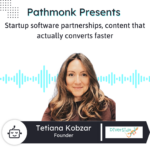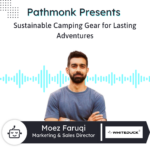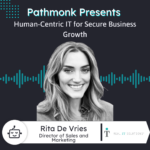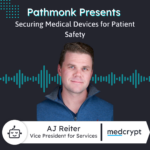
Introduction
Join us as we chat in this new episode of Pathmonk presents with Ari Khan, CEO, and Danielle Colvin, SVP of Marketing at Bridgeline, a software company dedicated to helping businesses grow their online revenue.
Discover their innovative solutions, including Hawk Search and Zeus AI, designed to increase website traffic, boost conversion rates, and maximize average order value.
This episode provides valuable insights into leveraging AI, optimizing the customer journey, and driving sustainable revenue growth in the digital landscape.
More Sales From Your Website With AI
Personalized interactions based on your users' behaviour to get +50% more conversions.
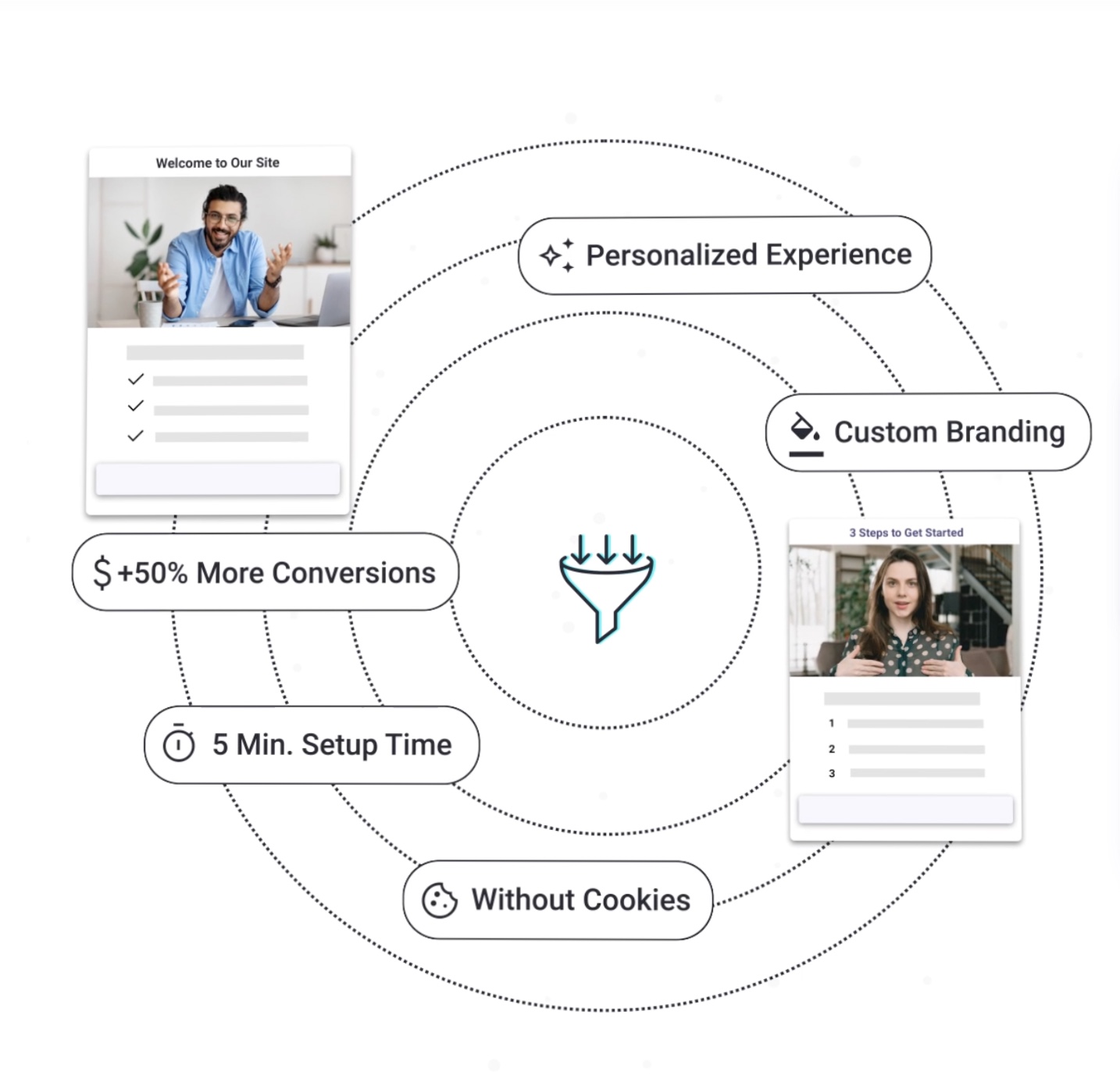
Ernesto Quezada: Pathmonk is the intelligent tool for website lead generation. With increasing online competition, over 98% of website visitors don’t convert. The ability to successfully show your value proposition and support visitors in the buying journey separates you from the competition online. Add Pathmonk to a website in seconds, let the AI do all the work, and get access to 50% more qualified leads while you keep doing marketing and sales as usual. Check us out on pathmonk.com. Welcome to today’s episode. Let’s talk about today’s guest. We have Ari Khan and Danielle Colvin from Bridgeline, President, CEO, and Senior Vice President of Marketing. How are you doing today, guys?
Ari Khan: Great, Ernesto, thanks for having us.
Danielle Colvin: Doing good.
Ernesto: It’s great to have you guys on and interesting to learn a little bit more about Bridgeline. I’m sure you guys have a lot of news, AI news, and I’m sure listeners are tuning in wondering what Bridgeline is all about. So let’s kick it off with that. In your own words, tell us a little bit more.
Ari: Sure, sure. Bridgeline is a software company and we help our customers grow their online revenue. We’ve got three groups of products that do this. Groups that increase the traffic for the website, those that increase the conversion rate of that traffic into actual buyers, and then products that increase the average order value of each of those buyers. Hawk Search is one of our best-selling products right now and we’re very excited that we’ve recently released Zeus from Smart Search and the Athena release, Zeus 2.0, so to speak, is coming out imminently.
Ernesto: Awesome. Great to hear that from you guys. So that way our listeners could get a better understanding of Bridgeline. What would you say is the key problem that you guys like to solve for clients?
Ari: Well, it’s all about revenue, right? There’s the old saying that CEOs have two problems in the world, revenue and everything else. So we’re helping them with number one. We recognize that it’s very difficult to attract customers to your site, get those visitors to your site to actually buy something, and then get them to come back or to buy more and to really create the value that turns them into long-term customers. And we’re all about that.
Ernesto: Okay, perfect. Awesome. Great to hear that from you, Ari. On that note, is there a specific vertical segment that you guys like to go for? Is there an ideal ICP for Bridgeline?
Danielle: I mean, it certainly depends on the product. For Hawk Search specifically, our ICP, we tend to lean more into B2B. I know Ari always gives the quote about every B2C purchase having like, what, three or four B2B purchases behind it. So we support a lot of B2B businesses, especially mid-market, all the way up through to enterprise B2B businesses, distributors, wholesalers. Within those companies, we specifically target marketers and merchandisers. Anybody in charge of the e-commerce part of their business. That is our main group that we like to focus on helping and helping them reach their KPIs and again, as Ari said earlier, grow revenue.
Ari: I think that’s really important, right? You have to know who your customer is within the customer. First of all, we go after narrow segments. So as Danielle mentioned, B2B distributors, but that’s still even too wide. So we’ll do B2B campaigns and B2B electrical component distributors, plumbing distributors. Very narrow. But then knowing that exact person, the VP of e-commerce, what their bonus metrics are, what they wake up in the morning concerned about, and make sure that we’re driving value for those specific needs is the right way to market.
Ernesto: Absolutely important. Great things. For the listeners who are tuned in, how do they usually find out about Bridgeline? Is there a specific channel that you guys use for acquisition?
Danielle: We’re everywhere. We go to conferences, especially, as Ari mentioned, vertical-specific conferences. We’re a part of associations for specific industries, like the National Association of Electrical Distributors. We like to be where our customers’ main conferences are. We travel everywhere, and we also have large campaigns on LinkedIn. We currently have a weekly webinar series that people can reach at Hawknest if they’re looking to learn more about AI and how AI can help merchandising and grow your e-commerce presence. We run a webinar on that. We also have a podcast where Ari discusses AI. So if you guys want to learn more about e-commerce, AI, the revenue revolution, you can find Ari there. We use that as well to educate people about AI and how it supports e-commerce.
Ernesto: Awesome. Great to hear that. For our listeners to go ahead and visit you guys, you can always check them out at bridgeline.com. What role does the website play for client acquisition?
Danielle: For our website, we definitely use it quite a bit for client acquisition. We allow our customers to learn more about our specific products, our features. We have sub-brands like hawksearch.com, woorank.com, truepresence.com for each of our product series within Bridgline as well, so people can go to each of those to learn about our products.
Ari: It’s interesting that the physical conference is back, right, post-COVID. It took a while for people to want to get out there, but when we evaluate our budget, Danielle does a very good job at tracking the original source for each lead and attributing every dollar to leads and the leads that convert. We’re seeing a great return on investment in physical conferences. We definitely invest in the websites and in podcasts and so forth. But when I, as a CEO, evaluate and approve budgets, Danielle comes to me time and again with airplane tickets and booths because the physical conference is back.
Ernesto: Great. Are there any tools or tips or methods that you would recommend to our listeners for website lead generation?
Danielle: For anything related to websites, I would always encourage people to have a really strong and organized CRM system hooked into it. We love HubSpot. I know a lot of marketers out there will say, oh, yeah, of course, but HubSpot is key to our wheelhouse and keeping our websites functional and tracking those leads coming in. As far as lead generation on those websites, I would say that one of the key things for us is having streamlined and organized forms and making sure that on the backend of those forms, we have people who can quickly identify where a lead has come from and follow up with them. All of our forms go straight to a specific person on the team who can quickly communicate with a customer or a lead on the website. I would say that one of the largest things is stay organized, have a clean CRM. If you can, use HubSpot.
Ernesto: Love HubSpot.
Ari: HubSpot’s doing just fine. They don’t need any advertisements.
Danielle: I know, I know.
Ernesto: I thought that it sounded like an advertisement.
Danielle: Somebody will turn it into an ad.
Ari: It’s interesting because, for 20 plus years, people have focused on content strategies to generate SEO, and that’s very important. With generative AI, there are a lot of advancements. It’ll be interesting to watch how the dynamics of Google versus generated content play off of each other and video and so forth. But I expect that to evolve. Our products have generative capabilities and what we see customers do often is they will have proprietary content that is not public on the Internet, but they want it to be somehow indexed and to drive traffic. For instance, we have an electrical distributor company with millions of products, some of which might be 25-30 years old. The specifications for those products are proprietary information. But if somebody searches for, you know, I need a transformer that is 25 amps and compatible with XYZ, although that information isn’t something they want to be public, they’d like to show up on the search result for that. Our software is able to create content for them that pulls that proprietary information, puts it inside of a website, and allows Google to still index that page, or for a search to index that page without that data being explicitly given. So there’s all sorts of really interesting changes in the way that SEO works and the site search works that are going to merge from these new capabilities in AI that have evolved so quickly in just the last 24 months.
Ernesto: Yeah, go ahead.
Danielle: I was just gonna say on top of that, because SEO, the way that the whole entire SEO industry is changing right now with these generative AI advances, the way that Google is going to be ranking things and the way that people will be searching is already changing this past year. There are massive changes in the way that people search for things online, the way that they use keywords versus asking questions or using concepts. All of these changes are huge, and I do think because of that, as marketers, we need to stick to the foundations of our goal, which Ari mentioned earlier. There are three areas within a website to drive revenue. There’s bringing traffic to the website, there’s converting traffic, and then also making sure that each customer that is checking out with their shopping cart is increasing the average order of their shopping cart. We need to stick to these foundational items. As everything starts to get more complicated, we need to remember if we have a lot of traffic coming into the site, but perhaps our conversion rate is really low. If you can change that conversion rate from 1% to 2%, that’s a huge game changer for your funnel, for your strategy. That’s huge. So you need to start looking at conversion rate optimization. But, you know, say you don’t have very much traffic coming into the site, but you have a huge conversion rate. Well, then you need to bring more traffic in. So understanding these foundational pieces of your revenue strategy is going to allow for you to be able to create a really strong lead generation machine out of your website.
Ari: And those analytics, which a lot of times you can actually even use AI systems to be able to model and help you understand whether you’re better off investing in traffic or conversion at some point. We’ve got a product, eCommerce 360, that helps do that. But those metrics, I mean, that goes back to the age-old question of, like, well, how good is a lead, right? I mean, all leads are not created equal. And if you charge your SVP of marketing to just generate a bunch of leads, I’m sure she can. Is it going to help revenue or not? You need to connect the dots between all of that. The metrics are really interesting, right? Oh, I increased my conversion from 1% to 2%. Actually, that means you just doubled your revenue. Two is 100% more than one. But if I increased my conversion from 50% to 51%, I still increased it by one, but I didn’t really make a big impact. And as I increase traffic, my conversion could go down, but my net sales could still go up. All of these different dynamics is a very complicated set. First of all, you can’t improve what you can’t measure. So you need to be able to measure everything and you need to be able to have some A/B testing to be able to experiment. But you also need to have some serious analytics in the backend to model out where you should make that next investment.
Ernesto: Definitely important. Awesome to hear from you guys on that. I mean, you guys, like the way you guys mention it, drive traffic, boost conversions, and raise AOV. It’s great to hear from you guys. Well, let’s switch gears a little bit here, and let’s talk about you guys as leaders. Ari, you being the CEO, Danielle, you being the SVP of marketing, two different things on a daily basis. But what do you guys focus on in your day-to-day work?
Ari: Okay, I’ll take that first. A big part of my focus is forecasting, right? We need to be able to allocate resources, not just marketing resources, but engineering and hosting and support and so forth. You can’t do that effectively if you don’t have strong forecasting. So I actually spend a lot of effort working with our finance team to understand what our revenue trends are. Really, it’s all about revenue, expenses. Relatively easy to understand. You don’t get blindsided with expenses so much because you can get blindsided with revenue sometimes or at the lag there. So we spend a lot of time focused on that. And then, of course, the human aspect of the equation, making sure that you’ve got teams that are motivated and are able to punch above their weight, so to speak.
Ernesto: And what about you, Danielle?
Danielle: On the marketing side, the constant goal that we are driving towards all the time is generating leads and making sure that we have a good support system for our sales pipeline. A lot of my work is making sure that we are bringing in high-quality leads, and that we are tracking those leads through a pipeline in an organized way. That way, we are able to make data-driven decisions, and it doesn’t, you know, we don’t just drop a list off and say, hey, here’s 500 leads to a sales team. Good luck. We follow that lead all the way through the process. We want to monitor our leads from their first touchpoint, their first experience with Bridgeline, all the way through to close. That is my main focus on a day-to-day basis, making sure that at each touchpoint we are able to track and improve their process through our sales pipeline.
Ari: One of the important things that Danielle has done is that she has created stages in the pipeline that are rigorously defined and unambiguously defined so that if you reach, for instance, one of her first stages, not the first, but one of them is the SQL sales qualified lead, which has very specific requirements. It doesn’t matter so much which requirement you have. What matters is that they be unambiguously defined so that you can, over time, forecast what percentage of leads that meet those specific criteria ultimately turn into a sale. This is how you build a forecast. So, like, what’s your SQL requirements?
Danielle: BANT. If anyone is familiar with budget, authority, need, timeline. Anyone in sales might be able to remember that one. We use need and timeline. If a lead comes in and they have a need for our product and they’ve expressed some kind of timeline, that’s very important for us. We also need two engagements from them, meaning that not our sales guy sending them ten emails, but the lead has sent us two emails back or phone calls, whatever it is. That’s very important for us in our SQL process. Our Salesforce guy, Ant, has done a wonderful job creating different formulas so that way we can automate the tracking of that. It’s not manual for anybody on the team and we can identify, this is an SQL, this is just a lead that needs to be warmed up, it needs to be nurtured. It goes into an engagement process.
Ari: So stages, really, there’s two things on my mind that are really important about having a pipeline with stages. The first one is forecasting, and that can only happen if every stage doesn’t have to be super rigorously defined, but you have to have enough rigorously defined that you can build up a history over time and see what percentage of leads that hit that qualification mark close, and then you can forecast. The second reason why it’s important to have stages in the sales pipeline is to create a process and a culture that is consistent. You can’t have a bunch of salespeople that are all doing their own thing and are too smart to follow the rules and so forth. It turns into chaos. It creates inefficiency. You don’t know which guy to send to a conference and which guy to believe when he says he’s got something that’s going to close by the end of the quarter and so forth. It always, you know, there’s a million processes and it doesn’t necessarily matter which one you use, but you have to use one. We use Sandler to educate people on the vocabulary within that process so that people are speaking the same language and are efficient. People are labeling their leads in the same way so that you understand who needs help and so forth. I really think that we’ve got a strong model for sales because we recognize those two aspects and we have rigor at every stage, but enough stages that you can create a trend.
Ernesto: Awesome to hear from you guys. Let’s jump into our next section, which is our rapid-fire question rounds. Are you guys ready for them?
Danielle: Sure.
Ernesto: First off, what is the last book that you guys read?
Danielle: Oh, boy.
Ari: Here we go. What is the name of it? Danielle, the writing book from Lebec. Aaron Lebec.
Danielle: High-Value Writing.
Ari: High-Value Writing. We bought like 20 copies of this, given it to everyone on Danielle’s team, every salesperson. High-Value Writing by Aaron Labeck. Great, fast read. Makes you into a super efficient communicator and a great writer.
Danielle: And if Erin Labeck ever watches this, we need her to know we’re her biggest fans. Bridgeline probably buys out all of her books on Amazon once a month.
Ari: I’ve even bought them for my brother and my niece.
Danielle: Yeah.
Ernesto: Great reads there. Next, is Zeus and Zeus 2.0 the main focus right now at Bridgeline, or is there something else going on there at the moment?
Ari: Yeah, so Zeus and Zeus 2.0, Athena, which are our internal code names for Smart Search, are definitely our main focus. This was driven a lot by Gartner, who really brought to our attention some of the latest trends in large language models and vector databases that we were already working on, but we didn’t realize how ready the market was for them. So thanks to them for that. Our engineering team, probably 75% of the people are working on Zeus, and the other 25% wish they were working on it.
Ernesto: Great to hear that. Next, if there were no boundaries in technology, what would be that one thing that you want to have fixed for your role as a marketer?
Danielle: Ari, do you have an answer for that one? I’m trying to think if I can.
Ari: I think that I would love to see consistent lead generation. So understanding where to go, a landing page, a video, whatever. And to be able to just have a pipe with a thousand good leads every week coming in. You automate that for me, and Danielle gets to go on vacation, and I get to sleep tonight.
Danielle: Yeah, that’s a big dream. I like that one. I agree with that 100%.
Ernesto: So do I. Lastly, you guys already have a lot of experience in the marketing world, but what is that one piece of advice that you would give yourself if you were to restart your journey as marketers today?
Danielle: Stay organized and do not forget the basics. You’ve got to keep to your foundational requirements as a marketer, the things that you learn as an intern. I feel like most marketers have either interned or earned their stripes in an agency at some point. Keep those foundational things that you learned. Double-check your subject lines in an email. Be very detail-oriented, stay organized, and don’t get sloppy. Those things are key to your success further down your career when you’re building massive marketing campaigns and trying to track a lead all the way through a pipeline, through multiple touchpoints, and you’re trying to manage a budget. Remember your foundational items. Check your details, remain organized, keep it simple.
Ari: I’ll add one thing to that. For every dollar you spend as a marketer, you need to be able to connect the dots in just two or three steps to revenue.
Danielle: Yeah.
Ari: Generate a lead that will close. Otherwise, I don’t know if you need to spend that dollar.
Danielle: Yeah. No balloons at the events are going to bring in a lead. Unless you.
Ari: Here’s the one thing to learn as a marketer. Don’t let your sales guys get drunk when you send them to a conference.
Danielle: Oh, my gosh. Make sure that they have food.
Ari: Conferences are not parties.
Danielle: Tell your vendors beforehand to hide the top shelf liquor during a happy hour. That’s the real key.
Ari: Yep.
Ernesto: Great to hear that. That’s some great advice for everybody in general. Before we end the show for today, I want to give you guys the last word. If someone forgets everything about the interview today, what is the one thing they should remember about Bridgeline?
Ari: Bridgeline helps grow your revenue. That’s all we live for. We make you successful by increasing online revenue.
Ernesto: There you guys heard it. You can always check them out at bridgeline.com. They’ll drive traffic, boost conversions, and raise that AOV for you guys. Ari, Danielle, thank you so much for being on. To our listeners, thank you for tuning in, and I’m looking forward to our next episode at Pathmonk Presents. Thanks a lot, guys.
Ari: Thank you, Ernesto.




